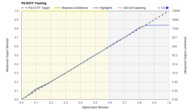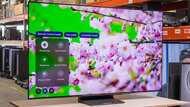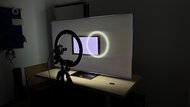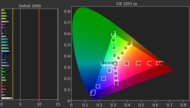Most TVs sold these days have a 4k resolution, except for a handful of 8k options and a few 720p or 1080p TVs. Since a lot of streaming content is in 4k, it's beneficial to have a 4k TV because it doesn't have to upscale anything. However, there's a lot more that goes into good image quality than just resolution, and that's why we perform over 350 tests on every TV we review. For example, contrast is the most important factor to consider if you use your TV in a dark room and want deep blacks. That's why OLEDs, with their near-infinite contrast ratios, are ideal for watching movies and shows in a dark room. If you mostly watch content in a bright room, you need a TV bright enough to overcome glare, and that's where good LED models typically excel.
Below are our recommendations for the best 4k televisions you can buy. You can also vote on which new models you want us to buy and test. To learn more about the 2025 models, check out our 2025 TV lineup page. For more options, check out our picks for the best 8k TVs, the best 120Hz TVs, and the best gaming TVs.

We buy and test dozens of TVs yearly, taking an objective, data-driven approach to deliver results you can trust. Our testing process is complex, with hundreds of individual tests that take over a week to complete. Most of our tests are done with specially designed test patterns that mimic real content, but we also use the same sources you have at home to ensure our results match the real-world experience. We use two main tools for our testing: a Colorimetry Research CR-100 colorimeter and a CR-250 spectroradiometer.
-
Best 4k TV
 Mixed Usage8.9Home Theater9.0Bright Room8.8Sports8.8Gaming9.3Brightness8.7Black Level10Color9.1Processing (In Development)8.3Game Mode Responsiveness9.4Motion Handling (Broken)7.7Resolution:4kNative Refresh Rate:165HzScreen Finish:MatteType:OLEDSub-Type:QD-OLEDDolby Vision:NoSee all our test resultsSizes:55" 65" 77" 83"
Mixed Usage8.9Home Theater9.0Bright Room8.8Sports8.8Gaming9.3Brightness8.7Black Level10Color9.1Processing (In Development)8.3Game Mode Responsiveness9.4Motion Handling (Broken)7.7Resolution:4kNative Refresh Rate:165HzScreen Finish:MatteType:OLEDSub-Type:QD-OLEDDolby Vision:NoSee all our test resultsSizes:55" 65" 77" 83"If you’re after a TV that excels in every area, the Samsung S95F OLED is currently the best 4k TV. It delivers a premium experience with exceptional picture quality, advanced gaming features, and impressive versatility. This QD-OLED model produces stunning colors that are vivid and accurate, so colors really pop off the screen. It displays inky blacks with bright highlights, making HDR content look spectacular, especially in reference conditions, like a home theater. Unlike many OLEDs that struggle with glare, the S95F handles bright rooms with ease thanks to its matte screen coating and excellent SDR brightness. Reflections are barely an issue, even in sunlit spaces. If you have a wide seating area, this TV is ideal since its image quality remains consistent even from sharp angles. It also includes Samsung's external Slim One Connect Box, which allows for clean cable management and flexibility when plugging in your devices.
Not only is picture quality top-notch, but it's also loaded with modern gaming features. It has four HDMI 2.1 ports that support 4K @ 165Hz, so it takes full advantage of the capabilities of modern consoles and is a solid pairing with high-end gaming PCs. It also supports all three major VRR formats, ensuring nearly tear-free gameplay regardless of the system you use. Combine that with nearly instantaneous pixel response times, and you get crystal-clear motion during fast action scenes. Some home theater aficionados might see the lack of Dolby Vision support as a downside. However, given its high brightness, the difference is minimal, and it still supports HDR10+, so it offers a comparable HDR experience.
-
Best Upper Mid-Range 4k TV
 Mixed Usage8.6Home Theater8.8Bright Room7.6Sports8.1Gaming9.1Brightness8.0Black Level10Color8.8Processing (In Development)8.4Game Mode Responsiveness9.4Motion Handling (Broken)7.9Resolution:4kNative Refresh Rate:144HzScreen Finish:GlossyType:OLEDSub-Type:QD-OLEDDolby Vision:NoSee all our test resultsSizes:42" 48" 55" 65" 77" 83"
Mixed Usage8.6Home Theater8.8Bright Room7.6Sports8.1Gaming9.1Brightness8.0Black Level10Color8.8Processing (In Development)8.4Game Mode Responsiveness9.4Motion Handling (Broken)7.9Resolution:4kNative Refresh Rate:144HzScreen Finish:GlossyType:OLEDSub-Type:QD-OLEDDolby Vision:NoSee all our test resultsSizes:42" 48" 55" 65" 77" 83"If you're interested in a QD-OLED TV like the Samsung S95F OLED but find it a bit too pricey, the Samsung S90F OLED is a great alternative that delivers very similar image quality. It uses a more traditional glossy screen coating and doesn't reach the same brightness levels in SDR, so it's not quite as effective at handling reflections. That said, its reflection handling is still solid, and it's bright enough for use in moderately lit rooms without distracting reflections on the screen. Fortunately, it has great HDR brightness that makes highlights stand out in HDR movies, shows, and games. When paired with its vivid colors and perfect black levels, you get stunning image quality, especially in dark environments. This makes it an excellent choice for home theater setups. It also has the same wide viewing angle as the S95F, ideal for large living rooms and other wide seating arrangements.
While it doesn't include Samsung's Slim One Connect Box, the S90F still features four HDMI 2.1 ports that support 4K @ 144Hz with VRR. It also offers the same nearly instantaneous pixel response times, ensuring smooth motion for even the fastest-paced games. Like the S95F and all Samsung TVs, this model doesn't support Dolby Vision, but it does include HDR10+, which provides a similar HDR experience. Unfortunately, only the 55, 65, and 77-inch sizes use a QD-OLED panel, whereas the other sizes use a WOLED panel. Even then, this varies depending on your region.
-
Best Mid-Range 4k TV
 Mixed Usage8.4Home Theater8.6Bright Room8.4Sports8.3Gaming8.4Brightness9.1Black Level9.2Color8.0Processing (In Development)7.8Game Mode Responsiveness8.0Motion Handling (Broken)7.8Resolution:4kNative Refresh Rate:144HzScreen Finish:GlossyType:LEDSub-Type:VADolby Vision:YesSee all our test resultsSizes:65" 75" 85" 98"
Mixed Usage8.4Home Theater8.6Bright Room8.4Sports8.3Gaming8.4Brightness9.1Black Level9.2Color8.0Processing (In Development)7.8Game Mode Responsiveness8.0Motion Handling (Broken)7.8Resolution:4kNative Refresh Rate:144HzScreen Finish:GlossyType:LEDSub-Type:VADolby Vision:YesSee all our test resultsSizes:65" 75" 85" 98"Although it doesn't offer the same level of image quality as the two Samsung OLEDs, the TCL QM8K is one of the best all-around Mini LED models on the market. It doesn't display the same perfect blacks as OLEDs, but it's surprisingly close, since its local dimming makes blacks incredibly deep and bold, with almost no haloing around subtitles and highlights. This is one of the brightest options on the market, and it has solid reflection handling, so it overcomes glare in most bright rooms, as long as you don't have any light sources directly shining onto the screen. Its high brightness also makes highlights really pop out in HDR content, so you get an impactful HDR experience in home theater settings. It also displays a wide range of bright and punchy colors, making it a versatile TV that looks great in any room.
Unlike the Samsung models, it only has two HDMI 2.1 ports, which might be limiting for those with several gaming consoles. However, those two ports support 4k @ 144Hz and 1080p @ 288Hz with VRR, so it takes full advantage of modern consoles and is a versatile choice for PC gamers. Pixel transitions are pretty fast for a Mini LED model, so motion blur is kept to a minimum in most games. Its viewing angle is good enough if you're watching from a slight angle, but image quality does degrade from more aggressive angles.
-
Best Lower Mid-Range 4k TV
 Mixed Usage7.8Home Theater7.9Bright Room8.0Sports7.9Gaming7.8Brightness7.8Black Level8.4Color7.5Processing (In Development)7.7Game Mode Responsiveness8.0Motion Handling (Broken)7.5Resolution:4kNative Refresh Rate:144HzScreen Finish:GlossyType:LEDSub-Type:VADolby Vision:YesSee all our test resultsSizes:55" 65" 75" 85" 98"
Mixed Usage7.8Home Theater7.9Bright Room8.0Sports7.9Gaming7.8Brightness7.8Black Level8.4Color7.5Processing (In Development)7.7Game Mode Responsiveness8.0Motion Handling (Broken)7.5Resolution:4kNative Refresh Rate:144HzScreen Finish:GlossyType:LEDSub-Type:VADolby Vision:YesSee all our test resultsSizes:55" 65" 75" 85" 98"If you like what the TCL QM8K offers, but need something cheaper, go with the TCL QM7K. Although it doesn't look quite as good as the QM8K, it still delivers great overall picture quality. Blacks aren't quite as deep as they are on the more expensive model, but they're still bold due to the TV's great local dimming solution, albeit with more noticeable haloing around highlights in dark scenes. The TV also has excellent peak brightness and decent enough reflection handling to overcome glare, so it's no slouch in a bright room, as long as you avoid placing any light sources directly opposite the screen. Colors are vibrant enough to please most people, and even though it's not as bright as the QM8K in HDR, the TV still displays HDR content with impact.
Like the QM8K, it has a narrow viewing angle, so it's best viewed from directly in front. Fortunately, the TV has the same selection of gaming features as the QM8K, including two HDMI 2.1 ports, 4k @ 144Hz, 1080p @ 288Hz, and VRR support to reduce screen tearing. It even has similarly quick pixel transitions, so motion has minimal blur behind it. This is a very solid option if you want a TV with good image quality, versatility, and a ton of features.
-
Best Budget 4k TV
 Mixed Usage7.1Home Theater7.2Bright Room7.0Sports7.1Gaming7.2Brightness6.5Black Level7.6Color7.2Processing (In Development)7.0Game Mode Responsiveness7.9Motion Handling (Broken)7.6Resolution:4kNative Refresh Rate:144HzScreen Finish:GlossyType:LEDSub-Type:VADolby Vision:YesSee all our test resultsSizes:55" 65" 75" 85" 98"
Mixed Usage7.1Home Theater7.2Bright Room7.0Sports7.1Gaming7.2Brightness6.5Black Level7.6Color7.2Processing (In Development)7.0Game Mode Responsiveness7.9Motion Handling (Broken)7.6Resolution:4kNative Refresh Rate:144HzScreen Finish:GlossyType:LEDSub-Type:VADolby Vision:YesSee all our test resultsSizes:55" 65" 75" 85" 98"If you like the gaming features found on the TCL QM7K but need something more budget-friendly, the TCL QM6K is a solid alternative. It includes the same core features as its more expensive sibling, including two HDMI 2.1 ports, support for 4K @ 144Hz, 1080p @ 288Hz, VRR, and relatively fast pixel transitions. Like the QM7K, it has a narrow viewing angle, so for the best image quality, it's best to sit directly in front of the screen.
While it doesn't match the image quality of the higher-end model, it still performs well. Colors are more muted but remain pleasing and don't appear washed out. Blacks aren't as bold, but they're still deep enough to give the image solid depth, especially for a budget option. One drawback is its lower HDR brightness, which means most highlights don't stand out as much as they should. Still, it delivers a decent HDR experience overall. Fortunately, its SDR performance is strong enough for well-lit rooms, as long as you avoid placing lights directly across from the screen. If you're looking for an affordable TV packed with features that also offers respectable picture quality, the QM6K is a great choice.
-
Best Cheap 4k TV
 Mixed Usage6.0Home Theater5.8Bright Room6.3Sports6.0Gaming6.2Brightness5.6Black Level4.9Color6.8Processing (In Development)6.3Game Mode Responsiveness6.7Motion Handling (Broken)7.0Resolution:4kNative Refresh Rate:60HzScreen Finish:GlossyType:LEDSub-Type:VADolby Vision:YesSee all our test resultsSizes:43" 50" 55" 65" 75" 85" 100"
Mixed Usage6.0Home Theater5.8Bright Room6.3Sports6.0Gaming6.2Brightness5.6Black Level4.9Color6.8Processing (In Development)6.3Game Mode Responsiveness6.7Motion Handling (Broken)7.0Resolution:4kNative Refresh Rate:60HzScreen Finish:GlossyType:LEDSub-Type:VADolby Vision:YesSee all our test resultsSizes:43" 50" 55" 65" 75" 85" 100"If you're looking for a low-cost TV that covers the basics, the Hisense QD6QF is the best cheap option we've tested that's widely available. The TV doesn't have local dimming like the other LED options on our list, so blacks aren't very deep at all and look gray in most scenes. It's also not a very bright TV, but it's just good enough to overcome glare in a room with moderate lighting. However, its limited brightness means highlights don't stand out in HDR, which leads to a lackluster HDR experience. Colors also look a bit underwhelming, since the TV struggles to display both bright and dark colors. However, it still displays a solid range of colors, so the picture doesn't look too muted. Unfortunately, like most LED models, its viewing angle is on the narrow side.
The TV isn't a great gaming TV overall, but it does support VRR to reduce screen tearing. 4k @ 120Hz isn't possible on this model, but it does support 1440p @ 120Hz. However, input lag is very high in that mode, so gaming feels sluggish. Fortunately, you can still game in 4k @ 60Hz with decently low input lag. Pixel response times are on the slower side, so fast motion is a bit blurry, but it's not too bad. If you're a hardcore gamer, you will want to look elsewhere, but the TV is fine for casual gamers who don't care about having high-end performance.
Notable Mentions
-
LG G5 OLED:
The LG G5 OLED is one of the top OLED TVs available and is a competitor to the Samsung S95F OLED. While the LG performs very well with color vibrancy, the Samsung still holds a slight advantage in this area. Furthermore, the LG has issues in some dark scenes, which can bother enthusiasts. Because the Samsung delivers more reliable performance and handles bright rooms better, it's the easier model to recommend.
See our review -
LG C5 OLED:
The LG C5 OLED is a good alternative to the Samsung S90F OLED. It performs better in bright rooms, but the Samsung offers higher brightness in its gaming mode and delivers more vivid colors with less banding, making it the stronger choice overall.
See our review -
LG B5 OLED:
The LG B5 OLED is a great choice over the TCL QM8K if you're a gamer. Being an OLED, the LG has smoother motion, which is great for faster games. Furthermore, the LG has a wider viewing angle, making it great for wide seating arrangements. However, the TCL is much brighter and offers more versatility, making it the superior option for mixed usages.
See our review -
Hisense U75QG:
The Hisense U75QG is comparable to the TCL QM7K but delivers higher peak brightness. However, it makes HDR content appear brighter than intended and shows more noticeable motion blur because of slower pixel transitions. With clearer motion, better black levels, and support for 1080p @ 288Hz, the TCL stands out as the better overall TV.
See our review -
Hisense U65QF:
The Hisense U65QF is a brighter alternative to the TCL QM6K, but it significantly overbrightens HDR content, which means it strays from the content creator's original intent. On the other hand, the TCL delivers a more well-rounded experience with deeper blacks, better color accuracy, support for 1080p @ 288Hz, and lower input lag.
See our review -
TCL S551G:
The TCL S551G is a solid alternative to the Hisense QD6QF. The TCL offers much lower input lag in its 1080p and 1440p @ 120Hz gaming mode, making it the better option for gamers looking for the best performance. However, the Hisense has better picture quality, so it's the better TV for most people looking for a cheap model.
See our review
Recent Updates
Oct 27, 2025:
Replaced the LG B4 OLED with the TCL QM8K in the 'Best Mid-Range' section, and replaced the TCL Q651G with the Hisense QD6QF in the 'Best Cheap' section. We also updated the Notable Mentions.
Jul 18, 2025:
We replaced the Samsung S90D OLED with the Samsung S95F OLED as our new top pick. We also replaced the LG C4 OLED with the Samsung S90F OLED in the 'Upper Mid-Range' category, the Hisense U7N with the TCL QM7K in the 'Lower Mid-Range' category, the Hisense U6N with the TCL QM6K in the 'Budget' category, and the Hisense A7N with the TCL Q651G in the 'Best Cheap TV' category. We also dropped the 'Best Bright Room' and 'Best Home Theater TV' categories, since the S95F and LG G5 OLED both outperform our old picks that were in those sections, the Sony BRAVIA 9 and Sony A95L OLED.
Apr 23, 2025:
Replaced the Roku Select Series with the TCL S5/S551G in the Notable Mentions since the TCL is the superior model. We also removed the TCL QM7/QM751G QLED from that section and mentioned it in the 'Best Lower Mid-Range 4k TV' instead. Additionally, we updated some text throughout the article for accuracy.
Dec 18, 2024:
Added the Roku Select Series to the Notable Mentions.
Oct 04, 2024: Swapped the LG C3 OLED, the LG B3 OLED, and the Hisense U6/U6K with their 2024 successors. We also condensed the article for clarity and updated the Notable Mentions.
All Reviews
Our recommendations above are what we think is currently the best 4k TV to buy for most people in each price range. We factor in the price (a cheaper TV wins over a pricier one if the difference isn't worth it), feedback from our visitors, and availability (no TVs that are difficult to find or almost out of stock everywhere).
If you would like to do the work of choosing yourself, here is the list of all our 4k TV reviews. Be careful not to get too caught up in the details. While no TV is perfect, most TVs are great enough to please almost everyone, and the differences are often not noticeable unless you really look for them. Also, keep in mind that our scores aren't comparable across different test benches, so most of the older TVs in the list below score higher than they would in 2025.
























